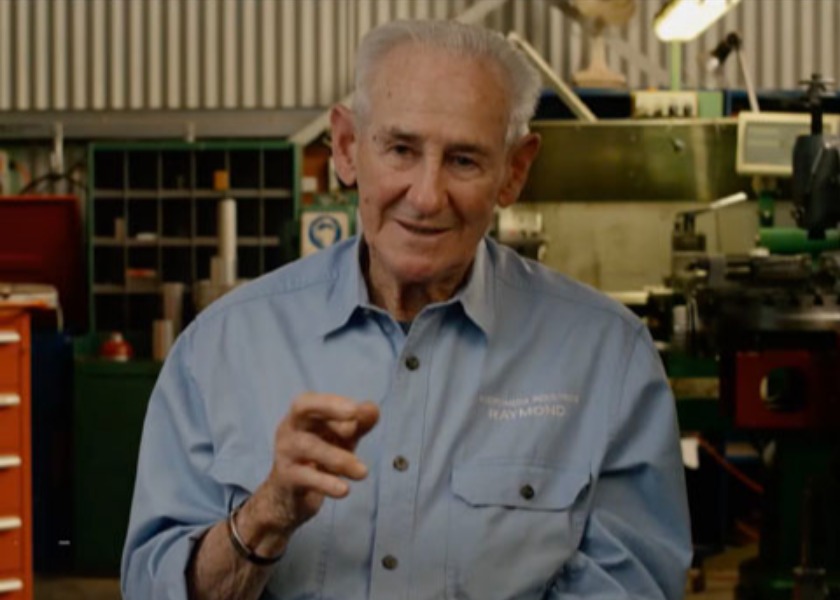
LEEA Lifting Legend Award
Raymond McLaren, Founder of Andromeda Industries, the Moonbi, NSW-based manufacturer of steel cable and rubber products, is the inaugural LEEA Lifting Legend.
The LEEA Lifting Legend Award honours our industry greats and the announcement of the inaugural winner was made during a special live webinar on 12 August, hosted by Justin Boehm, LEEA Regional Manager – Australia & New Zealand. The award is an Australia and New Zealand Regional Council initiative, with the recipient chosen a group of industry peers.
“We are excited to officially announce Raymond McLaren is the inaugural winner,” says Boehm. “Raymond is exemplary in his commitment to precision, care, safety and ingenuity. He just makes everyone around him better, makes the industry better and makes it safer. He’s just who we want to have as a LEEA Legend. Raymond’s impact goes well beyond the engineering side and his commitment to raising standards is exactly what LEEA is doing. If we can take a little bit out of his learnings, knowledge and his commitment to the industry and to his community, that’s something that we can all benefit from.”
Raymond McLaren is the founder of Andromeda Industries, established in 1972 as an innovator in the Australian wire rope industry. The family-owned business, based in rural New South Wales, offers a product range that includes Superflex, a plaited 12-strand wire rope. Andromeda takes round-stranded cable and plaits it into flexible and robust Superflex wire rope.
The making of a legend
From his earliest years, McLaren seemed to naturally know how things worked. He says: “I was born an engineer, I think, because by the time I was 15 I worked out the mechanism for a lever-action repeating rifle and made one. So I was able to conceptualise mechanisms. In my engineering studies at University College Newcastle, I learned the principles of mechanical engineering, which laid the foundations for my engineering know-how.”
His formative years learning about the trade commenced at Stewarts and Lloyd's tube makers and taking a mechanical engineering certificate course. During this time, McLaren was invited to try spearfishing, so he manufactured a spear gun. Asking how to attach the nylon line to the spear he was told to use a bow line and he realised he’d better start learning about knots. “That's really, in many ways, how it started.”
He borrowed a book that showed all the basic working knots as well as quite a few fancy knots. “Somehow or other they just interested me, McLaren explains. There’s a quiet brilliance in knots. Across the centuries, they’ve secured and built civilisations – from the ropes of ancient sailing ships to the intricate ringing of modern engineering. Knots have quietly shaped the progress of humanity, balancing simplicity with profound functionality. Is it any wonder a fascination with them became the spark of my life work?”
He was also intrigued by splicing wire ropes in rigging shops supplying industry. “It just seems to me that a splice was a magic thing, “ McLaren says. “Take a wire rope and it’s more or less useless unless it’s got an eye on each end. By putting a splice in, you make this wire rope into a sling. It just seemed like magic. And not only that, the splice is totally reliable and that interested me. I'd go up to the rigging loft at lunchtime and put in some splices. It was an interesting, fascinating thing and a hobby.”
Deciding to take an adventure to Cape York, McLaren gained a job running a power station, during which time he was asked to drive a crane. He also had to make his own slings. “That experience showed me the whole crane and lifting gear industry – what a crane does, how they work, how valuable they are, how essential they are and it also showed me that a sling has to be 100%, because I’d lift something off a barge that might be worth thousands of dollars.”
Making slings to order essentially started with a request from The Townsville Regional Electricity Board. Then, travelling around New South Wales, everywhere he went, people wanted the slings, which he produced using a splicing clamp in the back of his old Land Rover. “But I began to see we needed mechanisation.”
In 1967 McLaren moved to Tamworth, NSW and built the first press. When asked if he could make slings more flexible, that was the step from wire rope to Superflex cable. An Orbital Square Plaiting Machine was designed and built to plait steel cords producing the company’s Superflex plaited cable slings of a four by three sinet plait. This type of braided wire rope is known for high strength and non-rotating properties. “The plaiting machine took me three years to conceive the actual concept, two or three years to design it and another four years to manufacture the machine itself. So it took me 10 years.”
McLaren was also part of a group convened by industry luminaries to upgrade the old English standards for slings and rigging gear to an Australian standard.
Geoff Bower, Customer Relationship Manager at Andromeda Industries says McLaren has been instrumental in the Lifting Industry within Australia. “I think Raymond is very much a visionary with the products he has created over the years and for what he’s done with the development of Superflex cable, our steel flat woven slings, the fact that we now make the largest cable in Australia and the machinery to build all of that is a true testament to the man. He’s also been a very long standing community ambassador, always giving back to the community.”
McLaren’s phenomenal commitment to the community includes involvement in such things as the art precinct, the local school, the local museum, the local shop in Bicentennial Gardens, Castle Bushwalking Club, the Tingle Moombi Football Club, re-establishing the native flora and fauna, the Newcastle Bushwalking club. Engineering students from the high schools visit the company and the factory floor is opened up for the local men's group. He is also patron of the Tamworth Regional Astronomy Club.
Annette Williams, Company Director at Andromeda Industries says: “Raymond doesn't recognise how important he is and what he's done for the community, the Lifting Industry, the world.”
McLaren is also a proud LEEA member. “One of the honours of my life is becoming a LEEA member, he says. “When you’re invited to join LEEA it shows that you’ve got credentials, you’re worthwhile and that’s a great thing. It’s maintaining standards and maintaining quality, knowing that we’re doing a good job and knowing that people can rely on this.”
Bower adds: “LEEA is the epitome of the lifting and rigging industry. LEEA has high standards that everybody needs to be striving for. It is internationally recognised. I think it is critical to be part of LEEA. Raymond being part of it for such a long time is once again testament to understanding the need for quality and performance and having that standard.”
Asked to give some advice to inspire young people, McLaren says: “The main thing is to not lose that natural curiosity. We’re all born with it. In later years, I’ve taken interest in energy.” He adds: “The rigging gear industry is based on quality and integrity and every single component of a rigging assembly, especially the slings, have to be such high quality that they’re totally reliable. You need people of quality integrity to do that properly.”
McLaren concludes: “I've thoroughly enjoyed my journey in this industry. I've enjoyed my engineering and conceptual inventing capabilities to do this. I hope it carries on. I have a philosophy: we’re here to get things done, to find out things and to use that curiosity to make things better. I’d have to quote Odysseus before his last voyage, he said: ‘Old age has his honour and his toil yet something near the end, some work of noble note may still be done,’ so even at 86 I’m not finished.”
Watch the Lifting Legend webinar .



